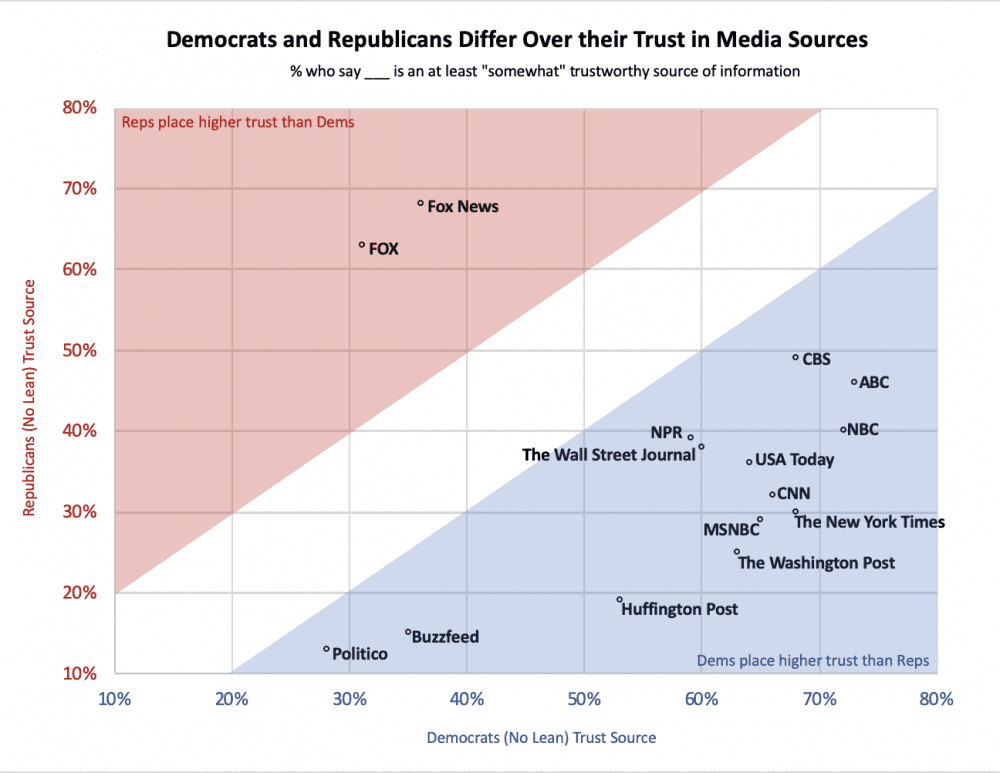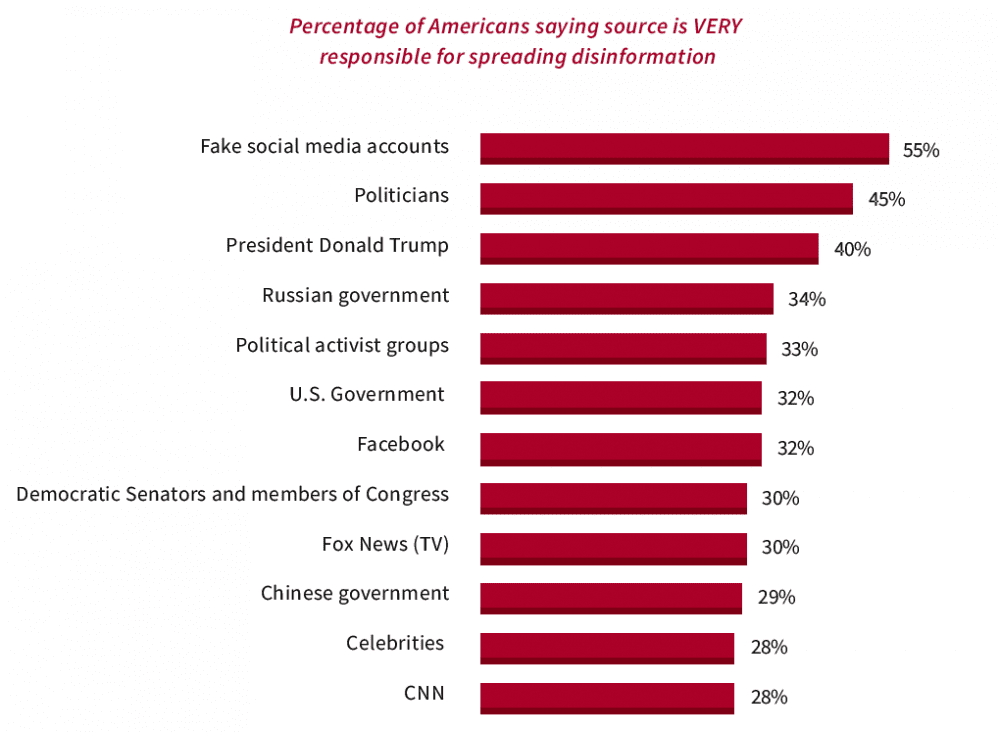
Download the full report: 2019 IPR Disinformation in Society – Full Report
Download the press release: Disinformation in Society – Press Release
Download the slides: 2019 IPR Disinformation in Society Report – Shareable Slides
Download social graphics: False News is a Problem, President Trump Key Findings and Disinformation Culprits
This is an IPR Signature Study.
Thank you to our sponsors:

Sixty-three percent of Americans view disinformation—or deliberately misleading or biased information—as a “major” problem in society, on par with gun violence (63%) and terrorism (66%), according to the 2019 Institute for Public Relations Disinformation in Society Report.
The 2019 IPR Disinformation in Society Report surveyed 2,200 adults with Morning Consult to determine the prevalence of disinformation, who is responsible for sharing disinformation, the level of trust in different information sources, and the parties responsible for combatting disinformation.
“One surprising finding was how significant of a problem both Republicans and Democrats rated disinformation,” said Dr. Tina McCorkindale, APR, President and CEO of the Institute for Public Relations. “Unfortunately, only a few organizations outside of the media literacy and news space devote resources to help fix it, including many of the perceived culprits for spreading disinformation.”
More than half (51%) of respondents said they encounter disinformation at least once a day, while 78% said they see it once a week. Four in five adults (80%) said they are confident in their ability to recognize false news and information. Additionally, nearly half of Americans (47%) said they “often” or “always” go to other sources to see if news and information are accurate.
Some of the findings of the study include:
Trustworthiness of Sources:
Regarding the trustworthiness of sources, the report reveals people are the most trustworthy sources of information: family (74%), people like me (72%) and friends (70%).
Of media sources, local newspapers (62%) and local broadcast news (62%) fared well for perceptions of trustworthiness and the ability to provide accurate news and information. Among newspapers, USA Today (47%) was viewed most often as a trusted source, followed closely by The New York Times (46%), The Wall Street Journal (44%), and The Washington Post (42%).
“The decline of local newspapers and cuts to journalism has created ‘news deserts,’” said Steve Cody, founder and CEO of Peppercomm and chair of the IPR Board of Trustees. “According to Dr. Penelope Abernathy at the University of North Carolina at Chapel Hill, 171 counties do not have a local newspaper and half of all counties only have a weekly newspaper. As one of the most trusted sources of information, not having sufficient local coverage is problematic.”
Political differences also play a role in the trustworthiness of sources. Democrats are more likely to trust mainstream media sources than Republicans, showcasing a wide gap between the two political parties. Compared to Republicans, Democrats were more likely to trust The New York Times (+38 percentage points), The Washington Post (+38 percentage points), and MSNBC (+36 percentage points). The exception is Fox News as Republicans were more likely to trust than Democrats (+32 percentage points).

Responsibilities for Spreading and Combatting Disinformation:
Forty percent of respondents deemed President Trump to be “very responsible” for spreading disinformation (40%), along with fake accounts (55%) and politicians in general (45%). However, there were differences between the two major political parties; nearly half of Republicans (45%) said President Trump was at least “somewhat” responsible, compared to 72 percent of Democrats.
For social media platforms, 64% of respondents said Facebook was “somewhat” responsible for spreading disinformation; more than half also said Twitter (55%).

Among groups and individuals trying to combat disinformation in the news, Americans give the most credit to “people like me” (55%), the Supreme Court (51%) and fact-checking websites (49%). Other groups and individuals considered to be doing at least “somewhat well” in their efforts are local newspapers (48%), TV stations (48%) and radio news (46%). The lowest scores for their efforts to combat disinformation in the news media go to CEOs (23%) and celebrities (23%).
Gaps existed between whom respondents thought should be combatting disinformation and how well they were actually combatting it. Seventy-two percent of Americans believe President Trump should be most responsible for combatting disinformation, but only 36 percent say he is doing at least “somewhat” well in combatting it. Similar gaps were found with the government (72% vs. 33%) and Congress (67% vs. 29%). Journalists saw a smaller gap as 64% said they should be responsible for combatting disinformation, but 44% said journalists were helping to combat it.
“Overall, respondents said every individual or group is responsible for helping combat disinformation,” said McCorkindale. “At least one-third deemed every source we listed as being ‘very responsible’ for combating information, including ‘people like me’ and ‘people not like me.’”
ISSUE BRIEF: Business-Related Sources and their Role in the Spread of Disinformation
This issue brief examines American attitudes toward certain business-related sources and their role in spreading disinformation. Included is a deep dive into the role of journalists, CEOs, public relations professionals, marketers and advertisers, and companies/corporations.
Download the Brief: Business-Related Sources and Their Role in the Spread of Disinformation
ISSUE BRIEF: POLITICAL AFFILIATION, THE MEDIA, AND DISINFORMATION
This issue brief examines how Republicans and Democrats differ in their perceptions of various media outlets and their role in disinformation. Included is a deep dive into local news sources, broadcast news, radio news, newspapers, and news-oriented websites.
Download the Brief: Political Affiliation, the Media, and Disinformation
ISSUE BRIEF: SOCIAL MEDIA AND THE ROLE OF DISINFORMATION
This issue brief examines the perceived role that social media platforms play in the role of disinformation. Included is a deep dive into Facebook, Twitter, Instagram, Snapchat, YouTube, and LinkedIn.
Download Social Media Issue Brief: Social Media and the Role of Disinformation
Methodology:
This poll was conducted between March 19-24, 2019 by Morning Consult with a national sample of 2,200 adults. The interviews were conducted online, and the data were weighted to approximate a target sample of adults based on age, educational attainment, gender, race and region. Results from the full survey have a margin of error of plus or minus two percentage points.
Thank you for reading our report! Stay tuned for more IPR Signature Studies coming soon!
IPR Disinformation Study Polling Presentation by Morning Consult
Report written by Tina McCorkindale, Ph.D., APR, President & CEO of the Institute for Public Relations. Special thanks to Doug Pinkham (Public Affairs Council) and Steve Cody (Peppercomm) for their contributions.
Contact us for more information about the 2019 IPR Disinformation in Society Report.

About the Institute for Public Relations: Founded in 1956, the Institute for Public Relations is an independent, nonprofit foundation dedicated to the science beneath the art of public relations™. IPR creates, curates, and promotes research and initiatives that empower professionals with actionable insights and intelligence they can put to immediate use. IPR predicts and analyzes global factors transforming the profession, and amplifies and engages the profession globally through thought leadership and programming. All research is available free at www.instituteforpr.org and provides the basis for IPR’s professional conferences and events.
All materials copyrighted by the Institute for Public Relations.




One thought on “2019 IPR Disinformation in Society Report”
Comments are closed.